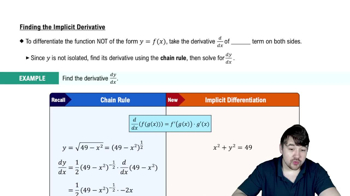Table of contents
- 0. Functions7h 52m
- Introduction to Functions16m
- Piecewise Functions10m
- Properties of Functions9m
- Common Functions1h 8m
- Transformations5m
- Combining Functions27m
- Exponent rules32m
- Exponential Functions28m
- Logarithmic Functions24m
- Properties of Logarithms34m
- Exponential & Logarithmic Equations35m
- Introduction to Trigonometric Functions38m
- Graphs of Trigonometric Functions44m
- Trigonometric Identities47m
- Inverse Trigonometric Functions48m
- 1. Limits and Continuity2h 2m
- 2. Intro to Derivatives1h 33m
- 3. Techniques of Differentiation3h 18m
- 4. Applications of Derivatives2h 38m
- 5. Graphical Applications of Derivatives6h 2m
- 6. Derivatives of Inverse, Exponential, & Logarithmic Functions2h 37m
- 7. Antiderivatives & Indefinite Integrals1h 26m
- 8. Definite Integrals3h 25m
4. Applications of Derivatives
Implicit Differentiation
Problem 3.8.23a
Textbook Question
13-26 Implicit differentiation Carry out the following steps.
a. Use implicit differentiation to find dy/dx.
³√x+³√y⁴ = 2;(1,1)
 Verified step by step guidance
Verified step by step guidance1
Start by differentiating both sides of the equation with respect to x. Remember to apply the chain rule when differentiating terms involving y, treating y as a function of x.
For the left side, differentiate the term ³√x, which can be rewritten as x^(1/3), and the term ³√y⁴, which can be rewritten as (y^4)^(1/3) = y^(4/3). Use the power rule for differentiation.
When differentiating y^(4/3), apply the chain rule: the derivative will be (4/3)y^(1/3) * dy/dx.
Set the derivatives of both sides equal to each other. The right side, being a constant (2), will differentiate to 0.
Solve the resulting equation for dy/dx, and then substitute the point (1,1) into your expression to find the slope at that specific point.
Recommended similar problem, with video answer:
 Verified Solution
Verified SolutionThis video solution was recommended by our tutors as helpful for the problem above
Video duration:
4mPlay a video:
Was this helpful?

 5:14m
5:14mWatch next
Master Finding The Implicit Derivative with a bite sized video explanation from Nick
Start learningRelated Videos
Related Practice



